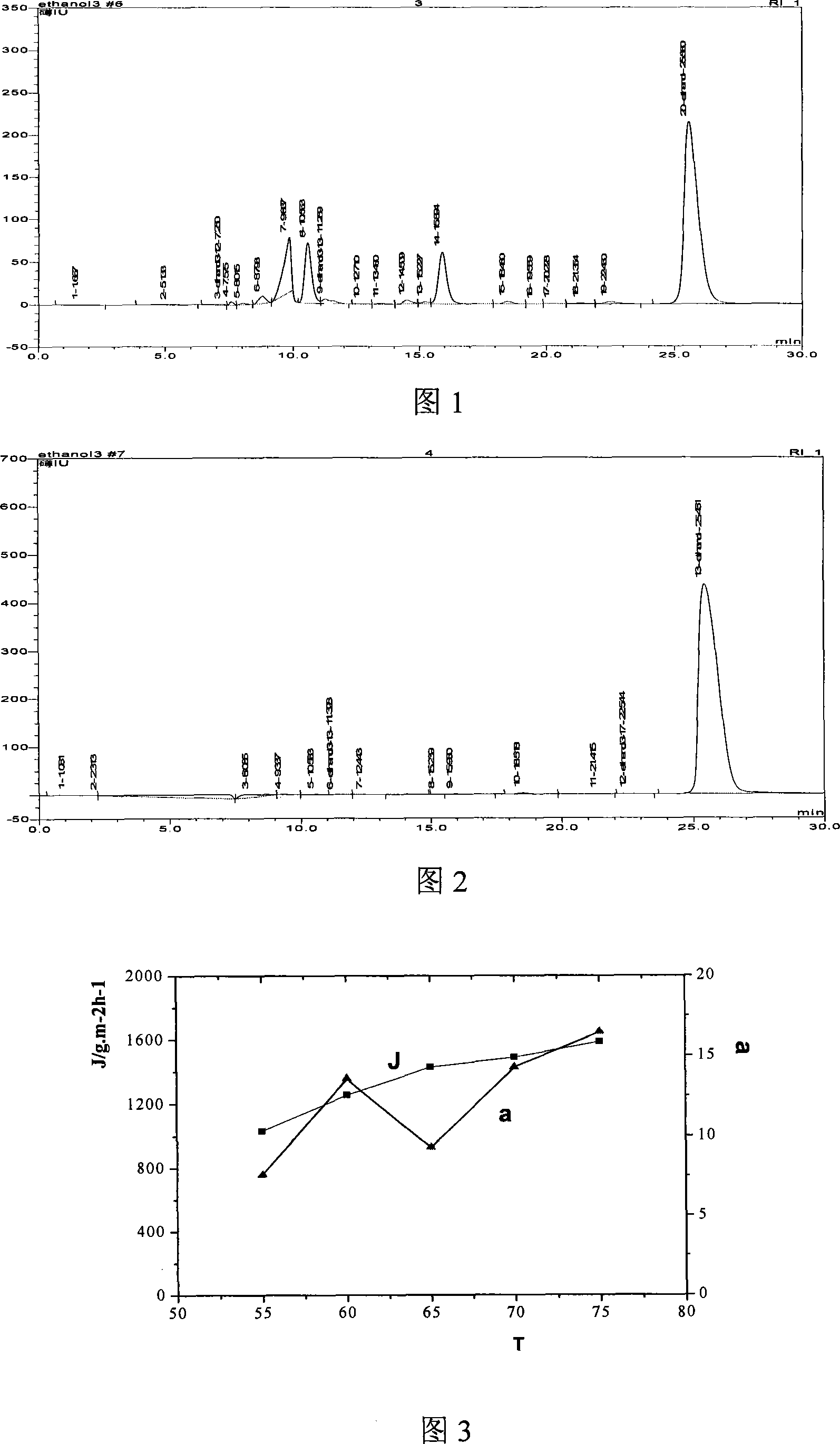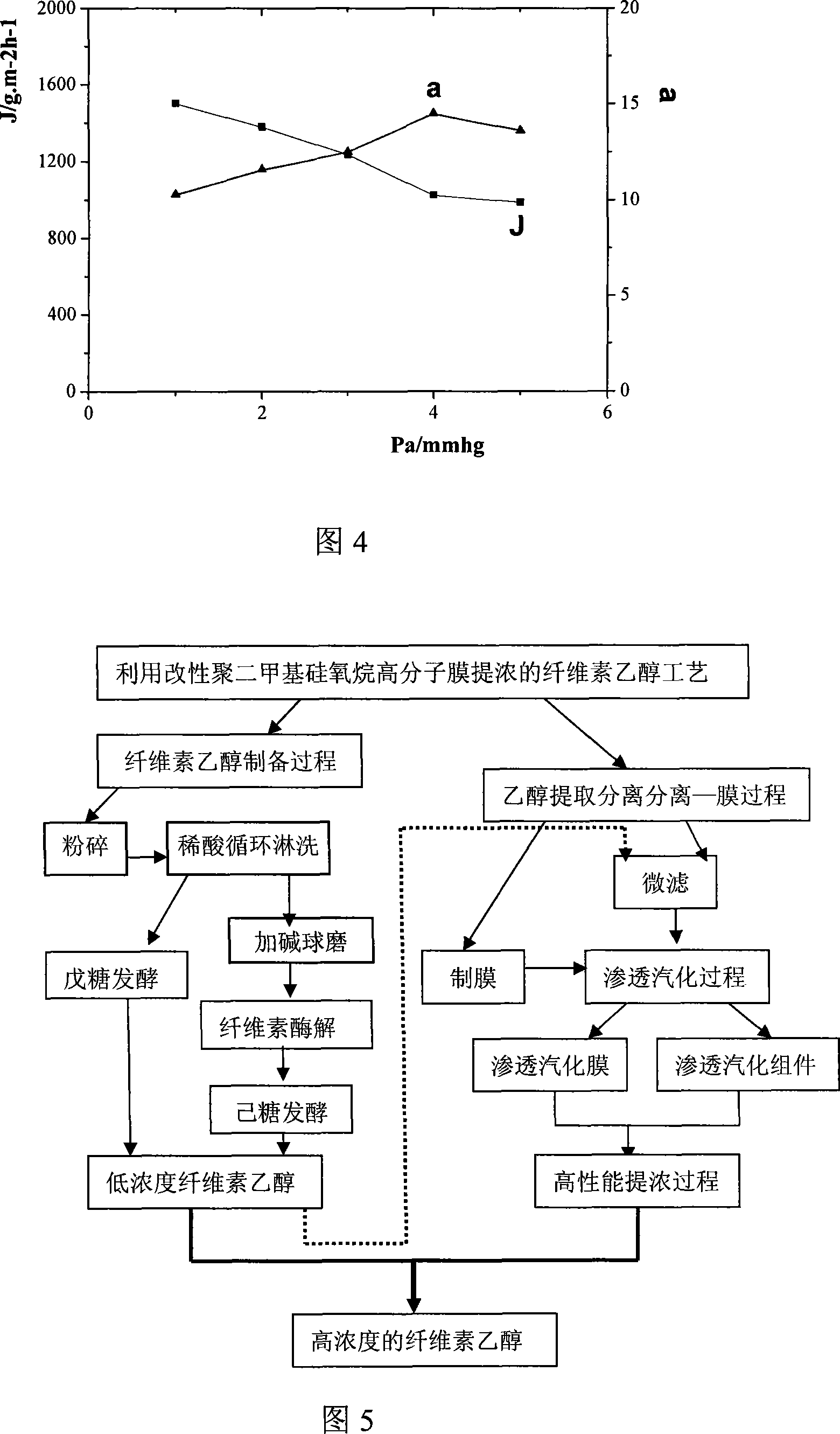Cellulose ethanol concentration by employing modified dimethyl polysiloxane polymer membrane
A technology of dimethylsiloxane and polymer membranes, applied in the direction of microorganism-based methods, biochemical equipment and methods, microorganisms, etc., can solve the problems of complex concentration process, low product concentration, high energy consumption, etc., and achieve separation performance Good, improved fermentation yield, high film-forming effect
- Summary
- Abstract
- Description
- Claims
- Application Information
AI Technical Summary
Problems solved by technology
Method used
Image
Examples
Embodiment 1
[0041] Example 1 Preparation of Film 1
[0042] Film-making material preparation: the mass percentage of each component is: polydimethylsiloxane 1 (molecular weight 3500), 5%, polydimethylsiloxane 2 (molecular weight 4500), 15%; inorganic additive ZSM -5, 1%; initiator azobisisovaleronitrile, 0.1%; solvent n-hexane 79%. Add catalyst at 25°C, 0.1%; stir for 10-20h, then cross-link at 60°C for 2-6h. Pour the reacted casting solution on a polytetrafluoroethylene plate, scrape the film with a scraper, and dry it in the air for 24 hours. The film thickness of the finally obtained interpenetrating network water deethanol pervaporation film is about 100 μm.
Embodiment 2
[0043] Example 2 Preparation of Membrane 2
[0044] Film-making material preparation: the mass percentage of each component is: polydimethylsiloxane 1 (molecular weight 3000), 10%, polydimethylsiloxane 2 (molecular weight 5000), 10%; inorganic additive ZSM -5, 2%; initiator azobisisoheptanonitrile, 0.2%; solvent n-hexane 78%. Add catalyst at 25°C, 0.2%; stir for 10-20h, then cross-link at 60°C for 2-6h. Pour the reacted casting solution on a polytetrafluoroethylene plate, scrape the film with a scraper, and dry it in the air for 24 hours. The film thickness of the finally obtained interpenetrating network water deethanol pervaporation film is about 100 μm.
Embodiment 3
[0045] Example 3 Preparation of Membrane 3
[0046] Film-making material preparation: the mass percentage of each component is: polydimethylsiloxane 1 (molecular weight 3500), 15%, polydimethylsiloxane 2 (molecular weight 5000), 15%; inorganic additive HZSM -5, 1%; initiator dimethyl azobisisobutyrate, 0.1%; solvent n-hexane 69%. Add catalyst at 25°C, 0.5%; stir for 10-20h, then cross-link at 60°C for 2-6h. Pour the reacted casting solution on a polytetrafluoroethylene plate, scrape the film with a scraper, and dry it in the air for 24 hours. The film thickness of the finally obtained interpenetrating network water deethanol pervaporation film is about 100 μm.
PUM
| Property | Measurement | Unit |
|---|---|---|
| Film thickness | aaaaa | aaaaa |
| Particle size | aaaaa | aaaaa |
| Osmotic flux | aaaaa | aaaaa |
Abstract
Description
Claims
Application Information
 Login to View More
Login to View More - R&D
- Intellectual Property
- Life Sciences
- Materials
- Tech Scout
- Unparalleled Data Quality
- Higher Quality Content
- 60% Fewer Hallucinations
Browse by: Latest US Patents, China's latest patents, Technical Efficacy Thesaurus, Application Domain, Technology Topic, Popular Technical Reports.
© 2025 PatSnap. All rights reserved.Legal|Privacy policy|Modern Slavery Act Transparency Statement|Sitemap|About US| Contact US: help@patsnap.com


